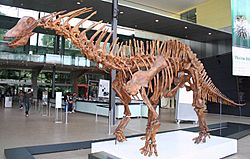Amargasaurus facts for kids
Quick facts for kids AmargasaurusTemporal range: Lower Cretaceous
130–125 mya |
|
|---|---|
 |
|
| Scientific classification | |
| Kingdom: | |
| Class: | |
| Superorder: | |
| Order: | |
| Suborder: | |
| Infraorder: | |
| Superfamily: | |
| Family: |
Dicraeosauridae
|
| Genus: |
Amargasaurus
|
Amargasaurus was a type of sauropod dinosaur. It lived during the early Cretaceous period, about 130 to 125 million years ago. Sauropods were large, plant-eating dinosaurs known for their long necks and tails. Amargasaurus was fairly small for a sauropod, growing to about 10 meters (33 feet) long. It walked on four legs and had a long, low head, much like its relative Dicraeosaurus.
This dinosaur was discovered in La Amarga, a canyon in Neuquén Province, Argentina.
Unique Features of Amargasaurus
Amargasaurus had a very special feature: two tall rows of spines. These spines ran along its backbone, from its neck all the way to its back. Scientists are not completely sure what these spines were for.
What Were the Spines For?
There are a few ideas about the purpose of these spines:
- Defense: The spines might have protected Amargasaurus from attacks. They could have made it harder for meat-eating dinosaurs, like theropods, to bite its neck or back.
- Display: The spines might have been used for showing off. Perhaps they helped Amargasaurus attract a mate or scare away rivals.
- Sail-like Structure: Another idea is that the spines supported a sail-like structure made of skin. This "sail" could have helped the dinosaur control its body temperature. It might have also been used for display.
The spines on its neck were especially long. They were split into two parts along their whole length, forming a double row. On its back and near its tail, the spines were not split. Instead, they had a paddle-shaped top. These unique spines make Amargasaurus one of the most interesting sauropods.
Images for kids
-
Casts of Amargasaurus and Carnotaurus, both discovered by the same 1984 expedition in Argentina, Natural History Museum of the University of Pisa
-
Size comparison between a human, Dicraeosaurus, Amargasaurus, and Brachytrachelopan
-
Skeleton cast showing the neck spikes pointing forwards during downwards bending, Museum of Paleontology Egidio Feruglio
-
Illustration of a pair of displaying Amargasaurus with cervical sail based on Cerda et al.
See also
 In Spanish: Amargasaurus cazaui para niños
In Spanish: Amargasaurus cazaui para niños










